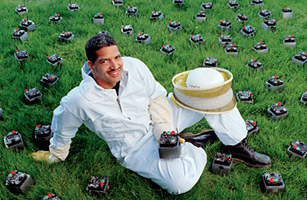
The M.I.T. grad student is busy testing his "swarmbots," mini-robots that work together to finish a task. "There are two robots on Mars," he says. "What if we had 2,000?"
The Swarm Keeper
When James McLurkin was a high school junior on Long Island, N.Y., he built his first robot: a toy car that he rigged with a keypad, an LED display and a squirt gun. Then he programmed the unit to travel to the next room and "engage the target." His parents — the target in question — got a good soaking.
McLurkin, 32, has come a long way since that first machine. Now a graduate student in computer science at M.I.T., the young scientist is on the forefront of developing "swarmbots" — packs of dozens of small robots that communicate with one another and work in harmony to complete an assignment. They have no centralized command system and can cover vast terrain; if one is destroyed, others fill in. His 112 titanium robots resemble small car batteries on wheels. McLurkin is working with a team at iRobot, a private Boston-based robotics firm, to find practical uses for his fleet of 4-in.-high units. McLurkin envisions that his swarm could map terrain on Mars or search for survivors in the aftermath of an earthquake. "If you want to know what's inside a cave, you can send in an Army Ranger — or an army of robots," he says of his fleet's lifesaving potential. Rodney Brooks, director of M.I.T.'s artificial-intelligence lab, says the scope of McLurkin's work is remarkable.
"A lot of us have worked on insect-robot things," he says, "but James has taken the technology farther than anyone else." Indeed, last year McLurkin won the prestigious Lemelson-M.I.T. prize for inventiveness and creativity.
McLurkin's machines were inspired by nature. As an undergraduate at M.I.T., he became interested in ants and kept a terrarium full of them on his desk. The decentralized nature of ant colonies gave him a model for his robots. "I worked on the notion of using virtual pheromones [the biochemical scents that some animals use to communicate]," he says. "As one robot gathers knowledge, it spreads it to its neighbors, and they spread it to their neighbors." Despite his success, McLurkin still gets a high-schoolish kick out of playing with his robots. Attendees at an iRobot holiday party two years ago were treated to the sounds of the first ever swarm orchestra. McLurkin had programmed the robots to arrange themselves into different instrument sections and play Christmas carols. What could be next? "A swarm marching band," he chuckles. "They'll play American standards."